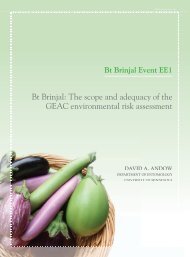English - pdf - 2145 Kb - Biosafety Information Centre
English - pdf - 2145 Kb - Biosafety Information Centre
English - pdf - 2145 Kb - Biosafety Information Centre
- No tags were found...
You also want an ePaper? Increase the reach of your titles
YUMPU automatically turns print PDFs into web optimized ePapers that Google loves.
Bio-based Building BlocksIn particular, synthetic biologists and chemists are attemptingto manufacture what they call ‘platform chemicals’ from asugar or biomass feedstock. These are key building blockchemicals that can in turn be refined into hundreds of otheruseful chemicals currently being produced in commercialrefineries. Commercial petrochemistry already takes thisapproach, cracking petroleum into essential building blockssuch as ethylene, butadiene, propylene and xylene and flexibleintermediates such as ammonia, acetic acid, carbolic acid andbutylene for refinement into thousands more. By targetingthese key platform chemicals or choosing new ones, chemistsdeveloping biobased substances are able to convert tens orhundreds of chemicals at one time from fossil carbon to plantcarbon. Examples of bio-based platform chemicals nowcoming to market include:Isoprenoids or terpenoids are a class of naturally occurringcompounds including rubber, taxol, neem, artemisinin andcannabinoids. Some of these have been produced in syntheticyeast by Amyris Biotechnologies, Inc. Amyris has focused onone isoprenoid called farnesene (which produces the acridsmell in apples), which they claim can be further refined into“a wide range of products varying from specialty chemicalapplications such as detergents, cosmetics, perfumes andindustrial lubricants, to transportation fuels such as diesel.” 299Amyris, whose synthetic yeast currently munch on Braziliancane sugar have an agreement with Procter &Gamble 300 toturn farnesene into cosmetics and household products. Theyhave a further agreement with M&G Finanziaria, the worlds’largest supplier of plastic for packaging bottles to use biobasedfarnesene in production of PET plastic. 301Genencorhas also engineered synthetic E. coli to produce isoprene usedfor rubber production. In 2008 they partnered with global tiremanufacturer Goodyear, Inc. to produce industrial quantitiesof tire rubber. They claim their ‘bioisoprene’ replaces theseven gallons of crude oil currently required to make onesynthetic rubber tire. 3021,3-Propanediol is a building block chemical that can be usedfor plastics, composites, adhesives, laminates, coatings and as asolvent in antifreeze and wood paint. Although usuallyproduced from ethylene oxide (a petroleum derivative), it hasnow been produced by Genencor in synthetic yeast as Bio-PDO, a precursor for DuPont’s bioplastic Sorona. DuPont, inpartnership with Tate & Lyle, currently produces 45,000tonnes per year of Bio PDO at its plant in Loudon, Tennessee,USA annually consuming 152,000 tonnes of corn (covering anarea of about 40,000 acres – roughly the size ofLiechtenstein). 303In June 2010, DuPont announced a 35% expansion ofproduction. 304 French bio-based products company,METabolic EXplorer also makes Bio-PDO, converted fromglycerol, a plant oil. The company estimates the global PDOmarket will reach 1.3 billion Euros by 2020. 305Succinic acid is a naturally occurring by-product of sugarfermentation that is a close chemical cousin to maleicanhydride – a petroleum-derived chemical used as a commonfeedstock for food and pharmaceutical products, surfactants,de-icers, coolants, detergents, plastics, pesticides, clothingfibres, and biodegradable solvents. Since it is possible totransform succinic acid into maleic anhydride, a number offirms are now competing to produce large quantities ofsuccinic acid, chasing a market that could be worth $2.5billion per year. 306 Those developing bio-based succinic acidinclude DSM and Mitsubishi Chemicals. BASF and Puracare developing a succinic acid plant in Spain and a 2000 tonneper year plant is already operational in Pomacle, France, usingmutant E. coli bacteria to produce succinic acid from wheatsugars. The plant is run by Bioamber – a joint venture of U.S.biotech company DNP and ARD (France’s Agro-industrieRecherches et Developpements). 307 In 2010 U.S.-basedsynthetic biology company Myriant received a $50 milliongrant from the U.S. Department of Energy to build a 14,000tonne bio-succinic acid plant in Louisiana. 308Ethylene is the gaseous raw material used in the manufactureof plastics including polyethylene (PE), polyester, polyvinylchloride (PVC) and polystyrene, as well as fibres and otherorganic chemicals. Usually made from naptha or natural gas,ethylene can also be made as a byproduct of ethanolproduction. Indeed in the 1980s Brazilian companiesproduced 160,000 tonnes of PVC and polyethylene (PE) fromethanol until world oil prices fell and the plants were closeddown. In 2008 three separate chemical companies, Braskem,Solavay and Dow Chemical, all announced they wouldrestart production of bio-based PVC and PE in Brazil andArgentina from sugarcane amounting to 860,000 tonnes peryear. 309Other companies to watch that are using chemistry andsynthetic biology to create bio-based chemicals and plasticsinclude:ADM/ Metabolix, BASF, Blue Marble, CargillNatureworks, Codexis, Draths Corporation, DSM,DuPont, Genomatica, LS9, OPX Biotechnologies, Segetis,Solazyme, Qteros and Zeachem.The New Biomassters 51











